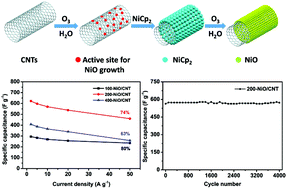Highly effective synthesis of NiO/CNT nanohybrids by atomic layer deposition for high-rate and long-life supercapacitors†
Abstract
In this work, we report an atomic layer deposition (ALD) method for the fabrication of NiO/CNT hybrid structures in order to improve electronic conductivity, enhance cycling stability and increase rate capability of NiO used as supercapacitor electrodes. A uniform NiO coating can be well deposited on carbon nanotubes (CNTs) through simultaneously employing O3 and H2O as oxidizing agents in a single ALD cycle of NiO for the first time, with a high growth rate of nearly 0.3 Å per cycle. The electrochemical properties of the as-prepared NiO/CNT were then investigated. The results show that the electrochemical capacitive properties are strongly associated with the thickness of the NiO coating. The NiO/CNT composite materials with 200 cycles of NiO deposition exhibit the best electrochemical properties, involving high specific capacitance (622 F g−1 at 2 A g−1, 2013 F g−1 for NiO), excellent rate capability (74% retained at 50 A g−1) and outstanding cycling stability. The impressive results presented here suggest a great potential for the fabrication of composite electrode materials by atomic layer deposition applied in high energy density storage systems.


 Please wait while we load your content...
Please wait while we load your content...